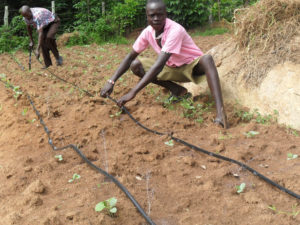by Ben Taylor

Drip irrigation system in Tanzania -favoured due to less wastage than traditional sprinkler systems – Food Ethics Council/ACE Africa
Survey report reveals obstacles to greater agricultural production
A new survey by the National Bureau of Statistics (NBS), has identified five key obstacles to agricultural productivity in Tanzania. The report, the National Sample Census of Agriculture 2019/20, named the issues as limited access to extension services, slow implementation of irrigation systems, low use of fertilizers, low use of improved seeds as well as underdeveloped mechanization.
It was revealed that only 5.2% of farmers practised irrigation farming in Tanzania, fertilisers were applied to 20% of cultivated land and 20% of land was cultivated with improved seeds. Hand tools (95%) and draft animals (26.5%) are used on much more cultivated land than tractors and power tillers (10.2%). And just 7% of crop-growing households received any advice from agricultural extension services, down from 67% a decade earlier.
Although use of irrigation has increased compared to a decade ago, the pace of growth remains slow. The report adds that investment in irrigation infrastructure is critically important for the agricultural transformation that will be required to adapt effectively to climate change.
Speaking at the report launch, agriculture minister Prof Adolf Mkenda acknowledged that productivity in the sector is still a major hurdle that limits farmers’ earnings and their contribution to the national economy.
He said the contribution of the crop sub-sector to the national’s Gross Domestic Product (GDP) is low at 15.4%, while in total the agriculture sector contribution is also not satisfactory at 26.9%. Livestock contributed 7.1%, fisheries 1.7% and forests 2.7% to GDP.
65.3% of households in Tanzania are involved in some form of agricultural production. It is the main source of income for approximately 36% of households.
In the twelve years since the previous such survey, the number of households engaged in agriculture rose by 34% to 7.8 million, while the overall national population rose by 40% over the same period.
Government priorities in agriculture
The ministry of Agriculture outlined seven areas the government will prioritise in the 2021/22 financial year to boost growth of the agriculture sector. These are research, seed development, extension services, increasing the amount of land under irrigation, strengthening markets for agricultural crops, improving access to inexpensive loans for financing agricultural investments, and improving preparedness against invasion of pests and crop diseases.
Agriculture minister Adolf Mkenda outlined the priorities in the Parliament in Dodoma when tabling his ministry’s budget for 2021/22. He said this was prepared based on the Five Year National Development Plan endorsed by Parliament in February and the CCM Election Manifesto 2020-2025, as well as the instructions issued by President Samia Suluhu Hassan issued in her maiden speech in Parliament.
In her speech, President Hassan said inefficiency was the main challenge facing the country’s agriculture, pledging that investment in the area will be made in the next five years to improve productivity.
The agriculture budget comes to TSh 294 bn, a 28% increase compared to the previous financial year. It includes TSh 3bn for increasing the country’s capacity to fight invasive pests and birds such as the desert locusts, including the purchase of new aircraft for this purpose. Extension services also see a major increase, from under TSh 1bn a year earlier to almost TSh 12bn this year.
While these increases did on balance attract praise from MP and commentators, an article in the (government-owned) Daily News, highlighted that the Kenyan government had allocated around five times as much to agriculture as Tanzania had done. For comparison, Kenya’s GDP and national budget are roughly 50% and 65% higher respectively than in Tanzania.
Avocados – the new green gold?
Close to 9,000 tonnes valued at $30 million were exported from Tanzania in 2020, up from almost zero seven years ago, driven in large part by increasing global demand.
Demand for Tanzanian avocados in particular is said to be higher due to the high quality of the product. The leading markets for avocados from Tanzania are the Netherlands and other European countries, South Africa, Dubai and other Gulf states. Recent years have also seen a big growth in demand from China and India.
It is estimated that over 10,000 farmers across the country are involved in avocado production. They produce an estimated 39,000 tonnes of the fruit each year, but only a quarter of this amount is exported.
Growth in demand has also led to sharp price increases. Farm-gate prices reportedly rose from TSh 450 per kg in 2014 to TSh 1,500 last year.
Commercial production of avocado has until very recently been concentrated in the southern highland regions, specifically Njombe District blessed with adequate water and cool conditions. This led to the construction of a state-of-the-art facility in Njombe where farmers can store their fresh produce and is also a hub to connect with buyers.
More recently, efforts are underway to encourage greater production in the northern regions of Arusha and Kilimanjaro. These regions have relatively easy access to global markets due to the proximity of Kilimanjaro International Airport, which specialises in exporting fresh agricultural products.
Despite the growth, exports from neighbouring Kenya are many times higher than Tanzania, with around 68,000 tonnes exported annually to the international markets.
